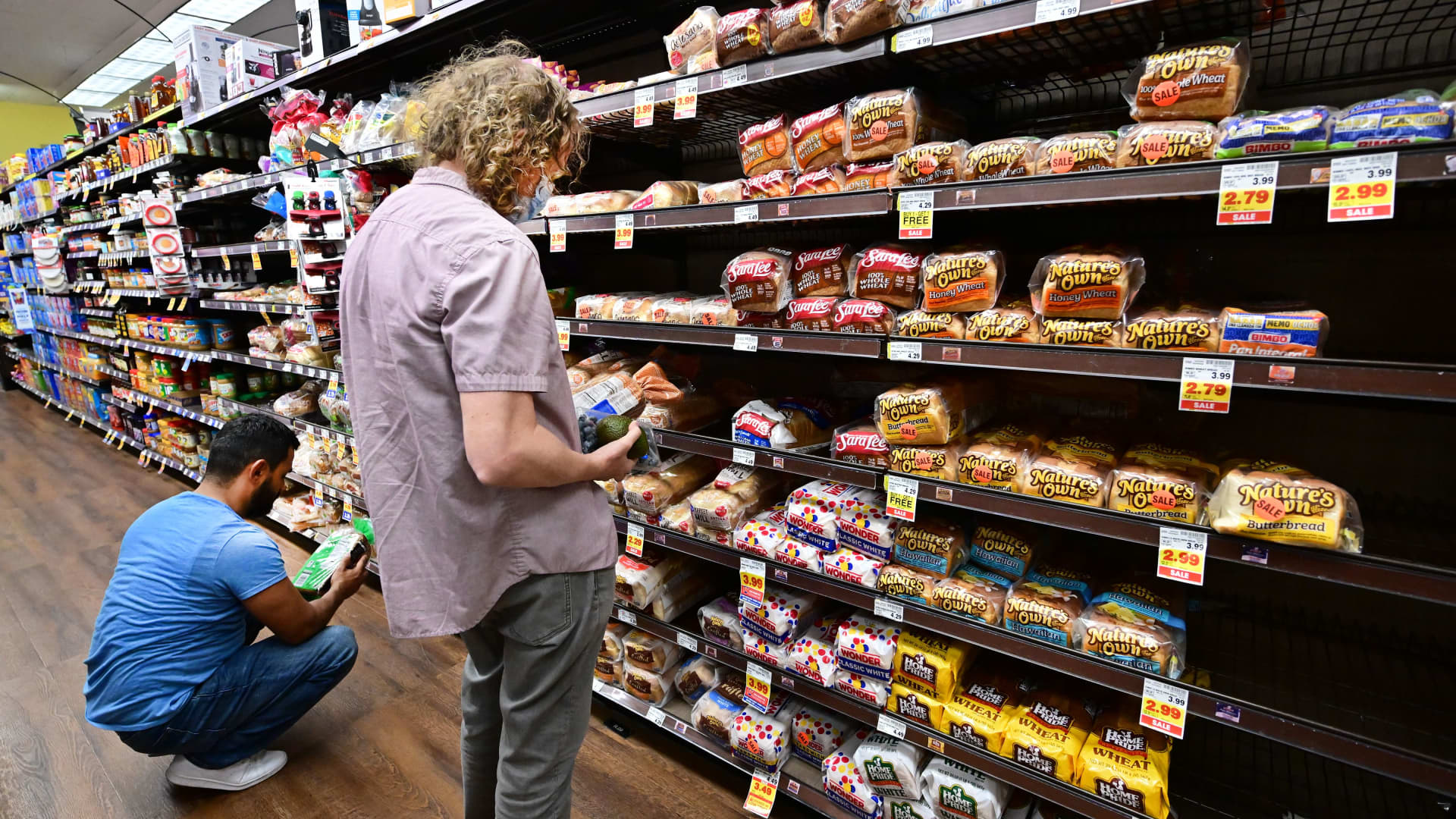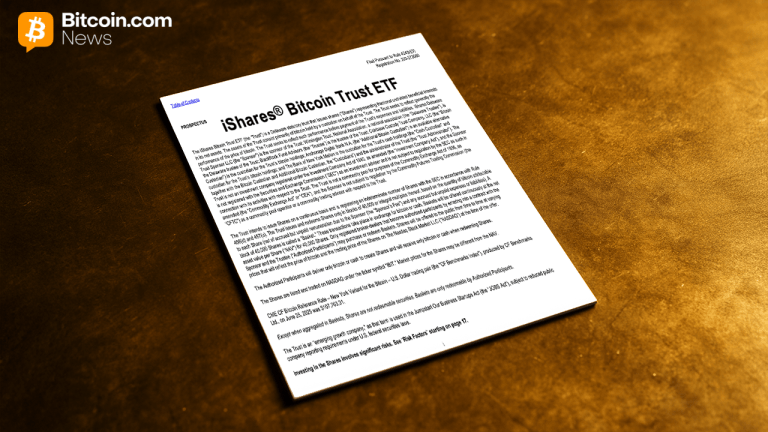Here’s the inflation breakdown for October 2022 — in one chart
6 min read
People shop for bread at a supermarket in Monterey Park, California on Oct. 19, 2022.
Frederic J. Brown | Afp | Getty Images
Inflation was cooler than expected in October, although household staples like shelter, food and energy remained among the largest contributors to consumer prices still rising at a historically fast pace, the U.S. Bureau of Labor Statistics said Thursday.
Inflation measures how quickly the prices consumers pay for a broad range of goods and services are rising.
The consumer price index, a key inflation barometer, jumped by 7.7% in October relative to a year earlier — the smallest 12-month increase since January 2022. Economists expected a 7.9% annual increase, according to Dow Jones. Basically, a basket of goods and services that cost $100 a year ago costs $107.70 today.
The annual rate is down from its 9.1% pandemic-era peak in June 2022 and September’s 8.2% reading, but is hovering near the highest levels since the early 1980s.
“That’s obviously still very high,” said Andrew Hunter, senior U.S. economist at Capital Economics, of October’s reading. “But at least it’s a move in the right direction.”
A decline in the annual inflation rate doesn’t mean prices fell for goods and services; it just means prices aren’t rising as quickly.
More from Personal Finance:
Consumers cut back on holiday gift buying amid higher inflation
How to avoid Medicare scams during open enrollment
Here are pros, cons of owning cryptocurrency in a 401(k)
While the headline annual reading is generally easier for consumers to understand, the monthly change is a more accurate gauge of near-term trends (i.e., if inflation is speeding up or slowing down), economists said.
The CPI rose 0.4% from September, according to the BLS. Economists expected a 0.6% monthly increase.
“For the past year to 18 months, we’ve seen a lot of 0.4%, 0.5%, 0.6%,” Hunter said. “It’s the reason annual inflation has been so high.”
Consistent monthly readings in the 0.2% range would suggest inflation was under control, he said.
The ‘pervasiveness’ of price increases
A healthy economy experiences a small degree of inflation each year. U.S. Federal Reserve officials aim to keep inflation around 2% annually.
But prices started rising at an unusually fast pace starting in early 2021, following years of low inflation.
As the U.S. economy reopened, a supply-demand imbalance fueled inflation that was initially limited to items like used cars, but which has since spread and lingered longer than many officials and economists had expected.
“That’s the crux of the problem: the pervasiveness of inflation,” said Greg McBride, chief financial analyst at Bankrate.
Inflation was a top concern for voters heading into Tuesday’s midterm elections. An NBC News poll issued last weekend found 81% of respondents were either somewhat dissatisfied or very dissatisfied with the state of the economy — a level unseen since the 2010 midterms.
The typical U.S. household spends $445 more a month to buy the same items it did a year ago, according to an estimate from Moody’s Analytics based on September’s CPI report.
Meanwhile, pay for many workers hasn’t kept pace with inflation, translating to a loss of purchasing power. Hourly earnings have fallen 2.8% in the last year after accounting for inflation, according to the BLS.
Food, energy and housing are top contributors
Large and consistent price increases in food, energy and housing have been troubling, despite some recent improvement, McBride said.
They’re necessities that constitute a large share of household spending, making inflation “so problematic” for households, he said.
“You can’t go without eating, you can’t go without cooking or heating the house and you need a roof over your head,” McBride said. “Those are three categories that continue to drive these high levels of inflation.”
Housing represents the biggest share of average consumer budgets, accounting for 34% of household spending in 2021, according to most recent U.S. Department of Labor data. Transportation (which includes gasoline) and food are No. 2 and No. 3, respectively, at 16% and 12%.
Any meaningful relief for household budgets is something that is still well over the horizon.
Greg McBride
chief financial analyst at Bankrate
Shelter prices increased in October, jumping 0.8% from September — the largest monthly increase in that category since August 1990, according to the BLS. The category is up 6.9% in the last year.
The “food at home” index — or grocery prices — jumped 12.4% In October versus the same time a year ago. That’s an improvement from 13.5% in August, which was the largest 12-month increase in over 40 years, since 1979.
The energy category — which includes gasoline, fuel oil, natural gas and electricity — was up 17.6% last month relative to October 2021. That’s a decline from September’s 19.8%.
“Any meaningful relief for household budgets is something that is still well over the horizon,” McBride said.
Gasoline prices had been a primary irritant for many Americans earlier in the year. Prices at the pump have retreated from summer highs of more than $5 a gallon nationwide, but edged up slightly in the past week; they currently sit at an average $3.80 per gallon, per AAA.
‘We have a ways to go’
“Core” inflation — a measure that strips out food and energy costs, which can be volatile — is important in terms of predicting future inflation trends, economists said.
The measure gives a sense of how broad-based inflation has gotten. Core inflation was 6.6% in September, the largest 12-month increase since August 1982. Core inflation was up 6.3% in October over a year ago; the index rose 0.3% during the month versus 0.6% in September.
Shelter, which includes rent, was the “dominant factor” in monthly increase in “core” CPI, according to the BLS. It accounted for 40% of annual core inflation.
The CPI generally lags price dynamics in the broad housing market and likely isn’t an accurate present-day snapshot, economists said. Home sales and mortgage volumes have slowed significantly, leading some to declare the U.S. is in a housing recession.
Other “notable” increases in the past year include medical care (up 5%), household furnishings and operations (8.4%), new vehicles (8.4%), and personal care (6.4%), the BLS said.
Monthly increases came from shelter, motor vehicle insurance, recreation, new vehicles and personal care, according to the BLS. There were also some monthly declines: used cars and trucks, medical care, apparel and airfares, it added.
“Price pressures remain evident across a broad range of goods and services,” Jerome Powell, chairman of the Federal Reserve, said during a press conference last week.
The central bank has been raising borrowing costs aggressively to cool the economy and reduce inflation. Powell signaled that policy would likely continue for the foreseeable future.
“I would also say it’s premature to discuss pausing [interest-rate increases],” Powell said. “And it’s not something that we’re thinking about; that’s really not a conversation to be had now,.
“We have a ways to go.”
Inflation isn’t just a U.S. phenomenon
Inflation isn’t a problem in just the U.S. Indeed, it’s been worse elsewhere.
For example, consumers in the United Kingdom saw prices increase 10.1% annually in September, tying a 40-year high hit in July.
But on the global stage, inflation first showed up in the U.S., Hunter said. That’s partly due to Covid-related restrictions unwinding sooner in many states relative to the rest of the world and federal support for households kickstarting the economic recovery.
“The U.S. has been a leading indicator for what’s happened to inflation in other countries,” Hunter said.
Inflation is a global problem worsened by geopolitical factors such as the ongoing Russian invasion of Ukraine. Pictured: damage in Donetsk, Ukraine, on Nov. 5, 2022, after shelling.
Anadolu Agency | Anadolu Agency | Getty Images
Americans had more disposable income as the economy reopened, the result of federal funds like stimulus checks and pent-up demand from staying at home. Meanwhile, Covid-19 lockdowns roiled global supply chains — meaning ample cash ran headlong into fewer goods to buy, driving up prices.
Those supply-chain issues are “only now beginning to unwind,” Hunter said. But higher labor costs — the result of ongoing worker shortages and wages that have risen near their fastest pace in decades — have led to upward pressure on the cost of services, too, he said.
Russia’s invasion of Ukraine also fueled a surge in commodity prices — for crude oil and grain, for example — which has fed into higher costs for gasoline and food, Hunter added.
High energy costs have broad ripple effects on other goods, which become more costly to produce and transport.
“I think this is something that will likely take much of 2023 to unfold, if we’re lucky,” McBride said.







